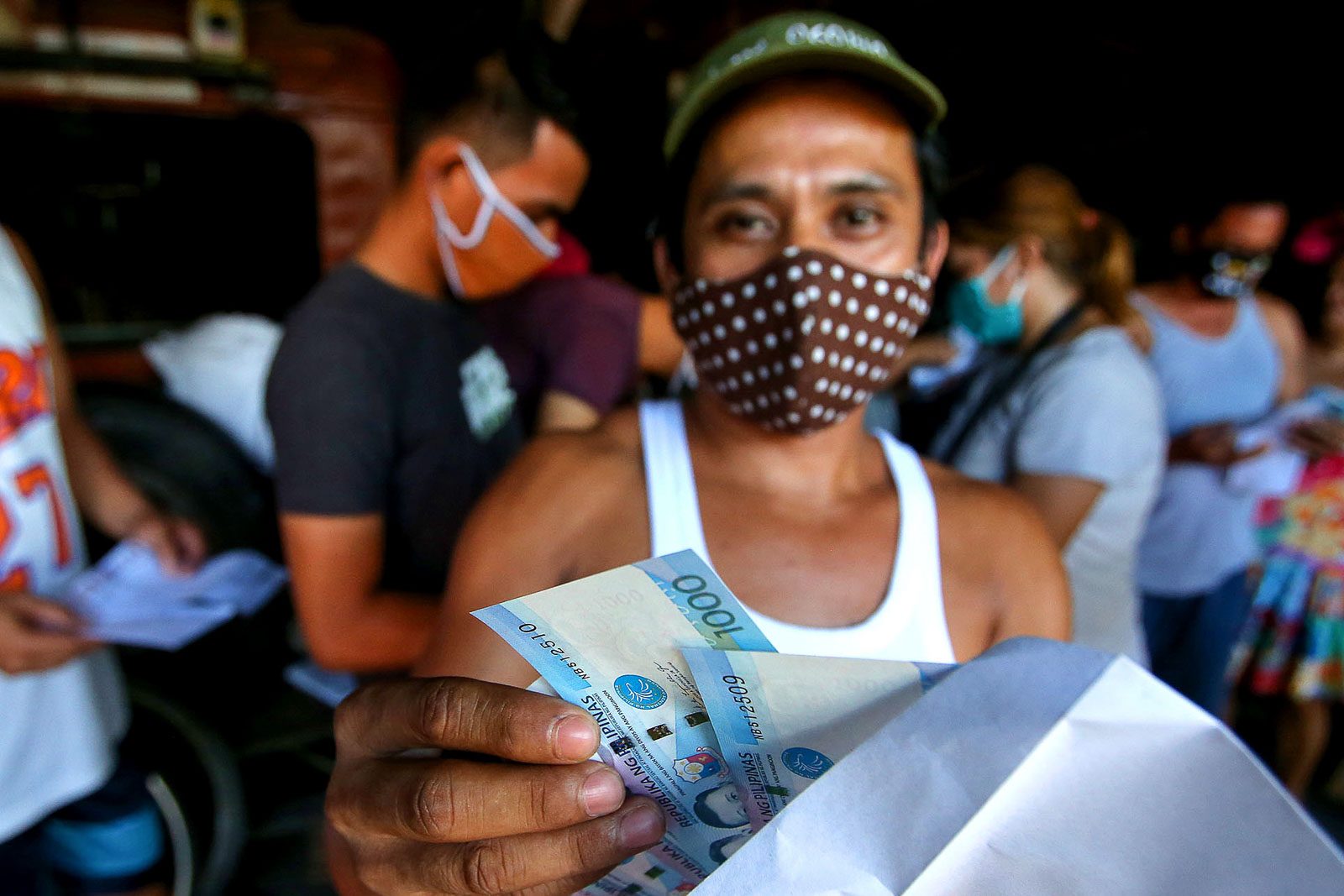SUMMARY
This is AI generated summarization, which may have errors. For context, always refer to the full article.

MANILA, Philippines (UPDATED) – The Department of Social Welfare and Development (DSWD) acknowledged “gaps and shortcomings” in distributing emergency funds through its social amelioration program (SAP).
The program is mandated under the Bayanihan to Heal as One Act to give financial assistance to the 18 million poor and vulnerable families that were affected further by lockdowns during the novel coronavirus pandemic.
In a taped broadcast shown past midnight on April 9, DSWD Secretary Rolando Bautista spoke alongside President Rodrigo Duterte and fellow Cabinet members to give updates on the program.
So far, the DSWD disclosed that it has been able to disburse emergency funds to the 3.7 million cash card holders of the Pantawid Pamilyang Pilipino Program (4Ps), public utility vehicle drivers, and several Metro Manila local government units (LGUs).
However, reports of confusion among who are the actual qualified beneficiaries have surfaced, as well as LGUs allegedly selling or photocopying social amelioration cards (SACs). (READ: Paano maaaring tumanggap ng tulong mula sa social amelioration program ng DSWD?)
On April 8, DSWD spokesperson Irene Dumlao said that the 18-million count of beneficiaries comes from the 15 million families included in the 2015 Listahanan – DSWD’s data collection system that identifies poorest households in the country. The DSWD added 3 million “as a projection of population growth” to come up with 18 million families in total.
Local governments ‘unfamiliar’ with constituent profiles
Based on the process released by DSWD, it’s the local government units (LGUs) that facilitate the information gathering and aid distribution between the DSWD and the beneficiaries. It is up to LGUs to come up with a list of beneficiaries that qualify for aid.
When DSWD transmits the funds to its field offices, the field offices coordinate with the LGUs for fund transfer.
“Dito naranasan natin na mayroong naging problema, kasi ang listahan ng mga taong babayaran siguro ang inexpect namin noon, na ang LGU, dahil alam nila ang constituents, ay they have the profile – names, work, at other activities. Dahil hindi rin nila masyadong kabisado, ngayon, dito nagkaroon ng problema,” said Bautista.
(This is where we encountered problems, because we expected the list of beneficiaries from the LGUs because they [should] know their constituents and have their profiles – names, work, and other activities. But because they did not memorize them, this is where the problem came up.)
Bautista noted the system was imperfect because it is the “first time” for the nation to experience such a situation. “Naniniwala ako na sa unang sitwasyon na ‘to, walang perfect na sistema (I believe that in this first time dealing with this situation, there is no perfect system). As we continue to engage the social welfare and development offices, we were able to identify the gaps and shortcomings. Hopefully in due time, we will be able to distribute the cash amelioration systematially and orderly,” he said.
Avoid overlapping subsidies
Bautista noted that one problem encountered is ensuring that there are no overlap subsidies in one family.
Apart from the DSWD’s amelioration program, other government agencies have their own emergency subsidy programs. He referred to the Bayanihan law that says families in need should receive an emergency subsidy of P5,000 to a maximum of P8,000.
“May mga pagkakataon na isang pamilya o isang miyembro ay benepisyaryo din ng Department of Labor and Employment (DOLE), Department of Agriculture (DA), or even Department of Trade and Industry (DTI)… Ang magiging problema nito pag di navalidate, magkakaroon ng duplikasyon ng mga benepisyong bibigay sa kanila,” said Bautista.
(There are instances where a family [qualified for SAP] has a member that is also a beneficiary of DOLE, DA, or even DTI. The problem here is if this is not validated, there will be duplication of benefits to be given to them.)
Bautista said that they are trying to avoid a situation where duplicate subsidies could have been used to cater to more families in need. He also emphasized the necessity of documentation to ensure accountability in case of errors.
On Wednesday, April 8, Senator Sherwin Gatchalian tweeted that only around half of the families in Metro Manila will get the SAP. The tweet presents a table of target beneficiary counts per Metro Manila LGU.
On the ave., only 53% of families in MM will get the SAP. The informal sector and no-work-no-pay or the near-poor can go as high as 85%. Ang mahirap pa, hahanapin pa natin sila by houses-to-house in one week. Baka tapos na EECQ, hindi pa sil makita. pic.twitter.com/N7qaFw3wL8
When asked if the numbers on the table are verified, DSWD spokesperson Irene Dumlao told reporters that they are “still studying this information.”
The Philippines is under a state of calamity due to the novel coronavirus pandemic. Luzon is under an “enhanced community quarantine” until April 30, and several other areas in the country declared lockdowns to curb the spread of the disease.
As of Wednesday, April 8, the Philippines has had 3,870 confirmed cases of COVID-19, with 182 deaths and 96 recoveries. – Rappler.com
(Editor’s Note: An earlier version of this story said that the DSWD has not explained the clear basis for the 18 million count of beneficiaries for the coronavirus assistance. We apologize for the error.)
Add a comment
How does this make you feel?
There are no comments yet. Add your comment to start the conversation.